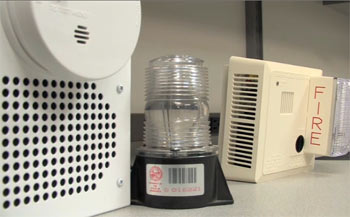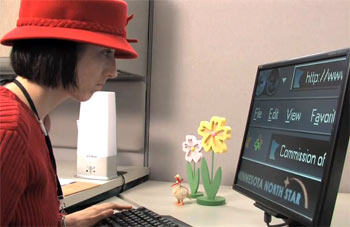
Alerting devices that flash or vibrate can help people with combined hearing and vision loss live and work safely.
Assistive technology that can help people who are DeafBlind falls into several general categories:
Alerting Devices
Alerting devices use a loud tone, flashing light or vibrations to alert people with hearing and vision loss to things in their environment that require a response. Common alerting devices include:
- Silent Call or VibraCall pagers
- All-in-one alerting systems
- Alertmaster pagers
- Baby cry signaler
- Carbon monoxide detector
- Doorbell signaler
- Fire and smoke alarm signaler
- Telephone signaler
- Wake-up alarm signaler
- Weather alert
- Security alarm
Telecommunications Devices
These devices use amplification, video and print displays to allow people who are DeafBlind to communicate with other people through technology. Common telecommunications devices include:
- Amplified telephone ringer
- Amplified telephone
- Portable phone amplifier
- TTY (sometimes called TDD)
- Braille TTY
- Video phone
- Video phone with Braille
- Voice Carry Over (VCO) telephone
- CapTel
- Telephones and remote controls with large buttons
- V-Touch phone with Braille

Screen magnification software helps make computers accessible to people with vision loss.
Computer Equipment and Computer Software
Accessible computer equipment and software are excellent tools that can help people who are DeafBlind to communicate. Common telecommunications devices that people who are DeafBlind may find useful include:
- Screen readers (i.e., JAWS)
- Magnification software programs (i.e., ZoomText, Big Shot)
- Braille displays (i.e., PowerBraille)
- Embossers (Braille printers)
- Large print computer software
- Braille keyboards
Hearing Aids and Assistive Listening Devices (ALDs)
These devices help some people with hearing loss to hear better by minimizing background noise and amplifying sound, etc. Common types of ALDs are:
- Hearing aids with T-coils or Bluetooth
- Audio induction loop
- FM system
- Infrared devices
- Personal amplifiers or “pocket talkers”
Captioning
Closed captioning allows people who are DeafBlind but still have some vision to enjoy television programs, DVDs and videotapes.
Low Vision Reading Aids
- Closed Circuit TV (CC-TV)
- Computer display magnifiers
- Video magnifiers
- Handheld magnifiers
- Illuminating lamps
- Standing magnifiers
Other Blindness/Low-Vision Assistive Technology
There’s a wealth of assistive technology devices available to help people with low vision access information and live independently. Here’s a sampling:
- Appliances with accessible controls
- Bold black markers and ivory or other soft-colored paper
- Braille writers (i.e., Perkins Brailler, Jot-A-Dot)
- Electronic books
- Electronic Braille notetakers
- Large print books, puzzles, cards, checkbook registers
- Talking alarm clocks
- Talking watches/Braille watches
- Teletouch
